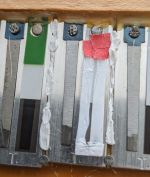Jaime_Dergut
Active member
Hello everybody,
so, since some months ago, I noticed that one the keys on my Honner has gone out of tune for it's musette register.
So, I tried to find out what was the issue of this.
Generally, I could not find any visible problem with it. So I guessed the problem was that the leather (or plastic, in this case) cover was the issue, so I covered it with teflon tape in order to prevent it from buzzing, and some red tape to hold it in place, but that didn't solve the issue.
So, I tried blowing up that particular reed ( I haven't made my bellow tester yet) and I realized that, if I hold the reed plate with something hard, the buzzing stops.
My conclusion was then that the reed plate was not attached firmly to the reedblock by the wax. So it needs to be rewaxed.
But I don't know how to do that yet, and I am not confident enough to try it on my expensive Hohner myself, so what I did was something more conventional.

I sneaked in some teflon tape between the gaps of the surrounding reed plates, so that will help to hold that one in place while transfering those vibrations to the reed block.
The result was that, it worked! The musette sound is back with its tremolo on it and I am satisfied. I was also able to fix a similar issue on a low reed plate. I know, it looks messy, but still worked.
Of course, this is a cheap fix until I am confident enough to rewax the whole thing myself.
What do you all think about this? Any advice? Suggestions? Destruc... I mean, constructive criticism?
Thanks for your time and attention.
Regards,
Jaime
so, since some months ago, I noticed that one the keys on my Honner has gone out of tune for it's musette register.
So, I tried to find out what was the issue of this.
Generally, I could not find any visible problem with it. So I guessed the problem was that the leather (or plastic, in this case) cover was the issue, so I covered it with teflon tape in order to prevent it from buzzing, and some red tape to hold it in place, but that didn't solve the issue.
So, I tried blowing up that particular reed ( I haven't made my bellow tester yet) and I realized that, if I hold the reed plate with something hard, the buzzing stops.
My conclusion was then that the reed plate was not attached firmly to the reedblock by the wax. So it needs to be rewaxed.
But I don't know how to do that yet, and I am not confident enough to try it on my expensive Hohner myself, so what I did was something more conventional.

I sneaked in some teflon tape between the gaps of the surrounding reed plates, so that will help to hold that one in place while transfering those vibrations to the reed block.
The result was that, it worked! The musette sound is back with its tremolo on it and I am satisfied. I was also able to fix a similar issue on a low reed plate. I know, it looks messy, but still worked.
Of course, this is a cheap fix until I am confident enough to rewax the whole thing myself.
What do you all think about this? Any advice? Suggestions? Destruc... I mean, constructive criticism?
Thanks for your time and attention.
Regards,
Jaime
